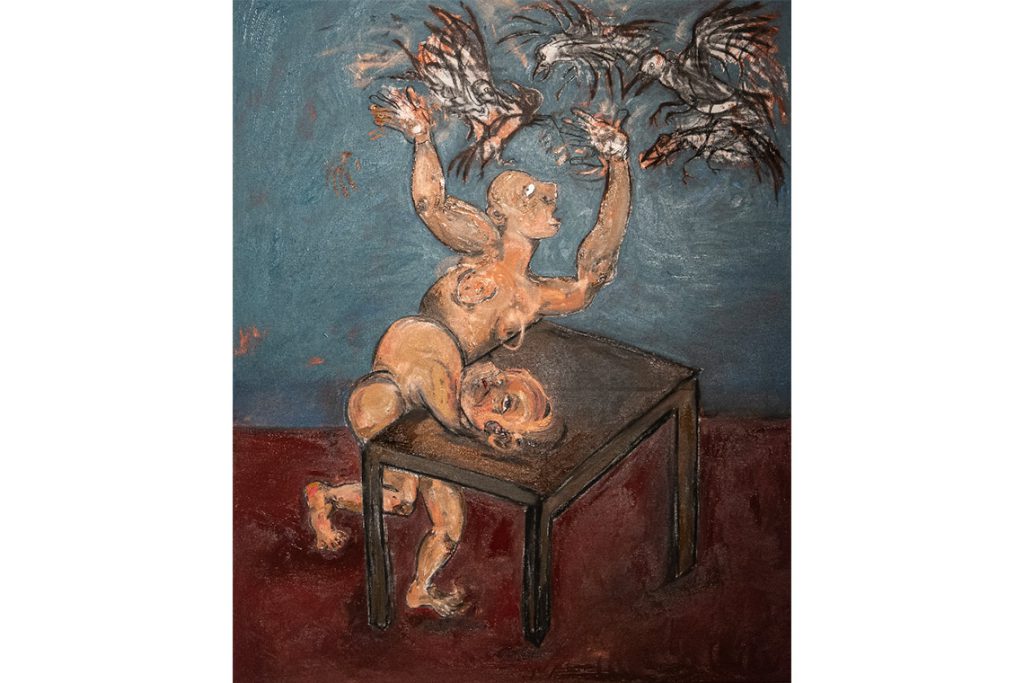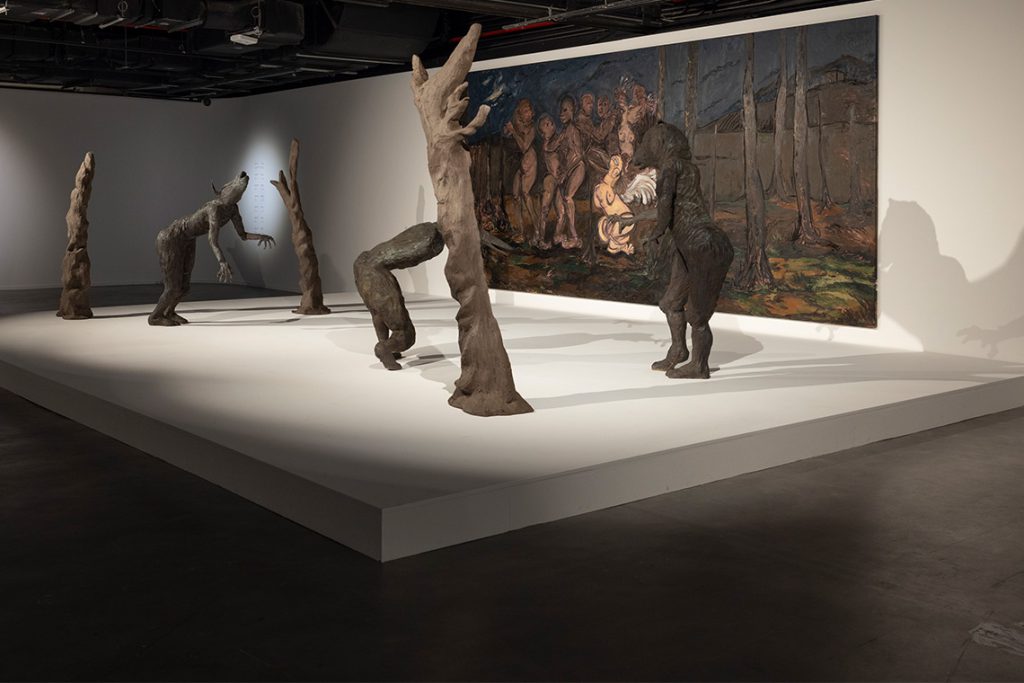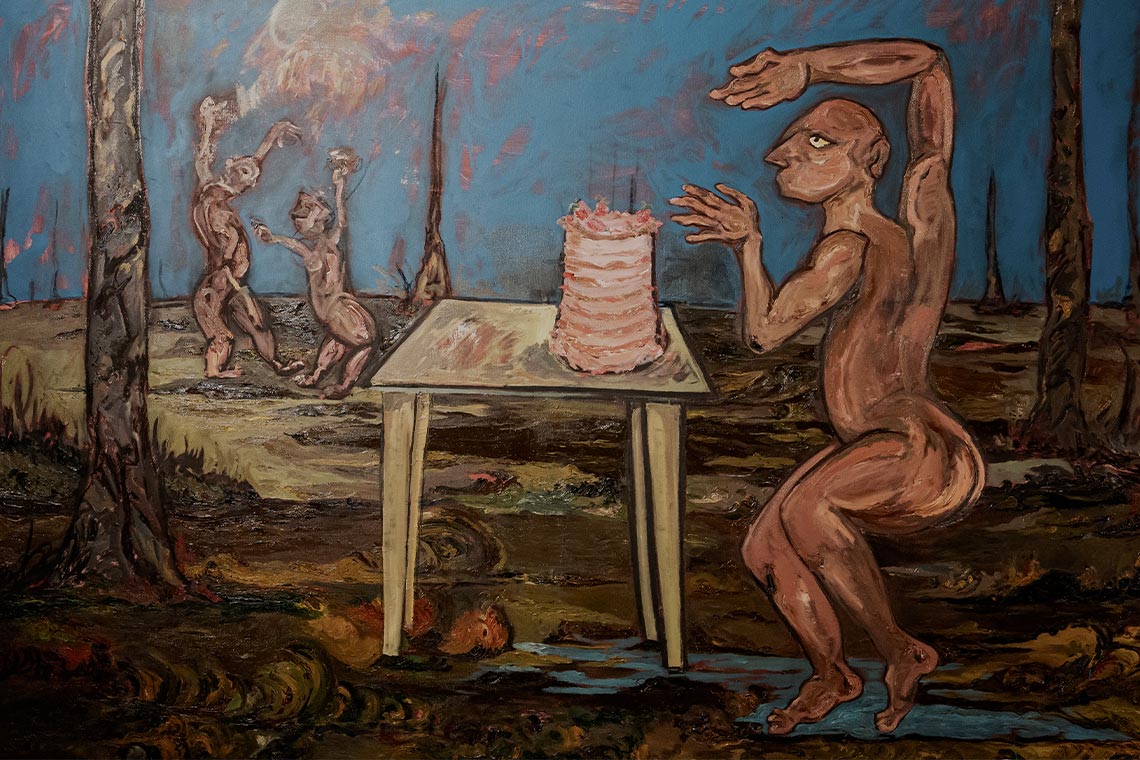Representing her first solo exhibiton at the Cultural Foundation in Abu Dhabi, Maitha Abdalla invites visitors into a dimly lit, emotionally charged space where the body becomes both a storyteller and site.
On the hushed first floor of the Cultural Foundation, Maitha Abdalla’s solo exhibition does not announce itself with spectacle. Instead, it murmurs a quiet invitation into a world that feels at once physical, emotional and mythological. The space splits in two: left and right. I chose the right, instinctively drawn to the darker space. It felt like entering a cave, or perhaps the unconscious.
During my visit, I had the space to myself, and the solitude amplified the encounter. The lighting was minimal, almost reluctant. Spotlights flickered into presence with restraint, never commanding attention but offering it conditionally. Here, light is not used to guide, but to suggest. The artworks hung on the walls emerge from the shadows slowly, as if deciding for themselves whether they wanted to be seen.
One particular piece stood out to me, It’s a Birthday: The Feast and the forgotten (2024). The central composition features a distorted humanoid figure on the right, couched in an almost dance-like pose, intensely focused on a layered cake placed on a fragile-looking table. Behind the table, two more grotesque figures engage in an ambiguous interaction, possibly celebratory or ritualistic. The entire scene unfolds in a barren, post-apocalyptic landscape dotted with warped trees and rendered in thick, almost volcanic textures. Symbolically, the piece seems to grapple with themes of existential longing, absurd celebration and the fragility of human ritual. The figuress gestures feel both ecstatic and desperate, suggesting a moment on the brink between celebration and collapse, creation and decay.

In contrast to the performative tone of the painting on the left, It’s A Birthday: The Toast (2024) conveys a sense of ritualistic stillness. A hybrid, double-bodied figure is contorted around a simple table, one half collapsed in resignation, the other erupting upward in chaotic motion. The figure’s upper torso strains toward a violent fury of black birds, whose wings slash the air with aggression and urgency. Their presence is ominous, less like creatures and more like manifestations of internal torment.
Further along, one enters a corridor, almost clinical and where a bench awaits. I sit almost instinctively, as if the space asks something of me. On the wall opposite, a forest scene comes into view, quiet, skeletal and almost breathless. In her video performance Flying closer to the Sun (2021), Abdalla appears barefoot and cloaked in black, a silhouette carved from shadow, standing still and solemn among the trees. She looks directly into the lens, unflinching, then draws a circle on the ground, as if protecting or claiming her space. She slips away, returning with a golden cloth, which she places on the ground with ritualistic care before vanishing once more. Suddenly, she reappears crawling, almost running, drawn to the cloth like a thread of memory or longing. She wraps it around her head, rises disoriented, then begins to move, her gestures at first seeming uncertain, searching as though she is questioning her presence within the space.
Disappearing again, she returns with feathers, her arms flapping in a trembling, birdlike motion. The golden cloth cascades from her head, its shimmer and texture adding a layer of uncertainty, both sacred and unstable. Her body begins to shift, evoking a creature in mid-transformation, no longer simply a woman but something wilder. Abdalla reclaims the image of a wild woman, untamed, and allows her to take a flight, if only for a moment within the silent resistance of the forest.

The next section of the show is like stepping into a dreamscape, almost a scene from a Narnia film. In The Dancer’s Skin (2022–23) the sculptures stand frozen yet thrumming with tension, as if caught mid-breath. Gathered together on a single white platform, they seem to float in a liminal space that is neither stage nor ground but something in between. The stark surface casts back the light, amplifying every shadow, letting them stretch and twist like echoes. Behind them, a five-metre forest scene on canvas unfolds, populated by fantastical creatures; some seem to be looking back, toward a house, maybe? Or perhaps searching for home, for belonging. The ambiguity remains.
Abdalla does not just create, she performs. Her work moves across painting, film and performance, yet it feels part of one long, intimate self-reflection. Her own presence lingers in every piece, not only through her physical gestures but also through the emotional charge they carry. By the end I felt as though I had wandered through someone else’s inner landscape and somehow found parts of my own reflected back.
Maitha Abdalla: Between Metamorphosis and Reality runs until 30 August



